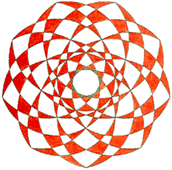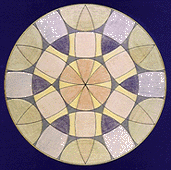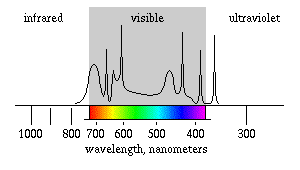|

|
Remo F. Roth
Dr. oec. publ., Ph.D.
dipl. analyt. Psychologe (M.-L. v. Franz)
|

|
© copyright 2002 by
Pro Litteris, Zürich. All rights reserved
Urheberrechtsverletzungen
werden international verfolgt. Genehmigungen zur Publikation von
Zitaten durch den Autor über email
With many thanks to Gregory
Sova, Ph.D. (LA, CA) and Phyllis Luthi (CA) for the help with the translation
Wolfgang Pauli and
Parapsychology
(part 3)
3. The psychoid and
the psychophysical archetype and Carl Jung's "second psychic
system"
3.1
Definition of the psychoid archetype
3.2 Psychoid and
psychophysical archetype, quasi-psychic realm and unified psychophysical reality (unus mundus)
3.3 Carl Jung's
"second psychic system" and its "very different world
view"
back
to part 2
Wolfgang Pauli and
Parapsychology
(part 3)
(Extended English version of the German
article)
3. The psychoid and the
psychophysical archetype and Carl Jung's "second psychic
system"
3.1 Definition of the psychoid
archetype
I can imagine that the above mentioned
conclusion of Wolfgang Pauli - that the assimilation of the psychoid
archetype (in the terminology of Jung) to physics is equivalent to
the inclusion of parapsychology and biology in it - is obviously not
yet understandable for the reader. Therefore we should explain the
term "psychoid archetype" and its connection with parapsychology. At
the same time we will see that this psychoid archetype is directly
related to a psychically experienced relativity of space and
time.
As Wolfgang Pauli already saw in 1946, Carl
G. Jung had extended the content of the term "archetype". Originally,
this term described a purely psychic phenomenon, however related to
the collective psyche. In an article of the same year [today in
CW 8, §§ 343] Jung suggested to supplement it - for the
explanation of phenomena he later called synchronicities - with the
term "psychoid archetype".
To explain the difference to the hitherto
existing term, he uses there the image of the physical light spectrum. To clarify his
thoughts, I will use a picture of it (fig.
3.1):

fig.
3.1
According to Jung we can - symbolically seen
- place the spiritual/psychic aspect of the archetype - the old
definition of it - at the ultraviolet end of the visible spectrum,
the psychoid archetype at the infrared end.
This conception of the psychoid archetype
will play a central role in my argument. Therefore I will specify it
here more exactly by using Jung's definitions. In the same article he
defines "psychoid" as "no psychic quality in the proper sense of the
word..., but only a 'quasi-psychic' one such as the reflex-processes possess," for purposes of distinguishing it from the specific
objective psychic processes he described till 1946. Later (1955) he
connects the psychoid processes not only with the reflexive ones of
the central nervous system, but also with those in the vegetative
nervous system:
"For just as a man has a
body which is no different in principle from that of an animal, so
also his psychology has whole series of lower
storeys in which the spectres from humanity's past epochs
still dwell, then the animal souls from the age of Pithecanthropus
and the hominids, then the 'psyche' of the cold-blooded saurian,
and, deepest down of all, the transcendental mystery and
paradox of the sympathetic and parasympathetic psychoid
processes." [emphasis mine]
This connection with the reflexive and with
the vegetative nervous system shows us that Jung feels a deep need to
delimit the psychoid from the purely spiritual/psychic archetype.
Thus, psychoid we call quasi-psychic processes, which are connected
with the vegetative nervous system as well as with the reflexive
nervous system, which means with the drives and instincts. Following
Jung's definition, we can say, as mentioned, that in the above image
the spiritual/psychic unconscious will thus occupy the ultraviolet
part of the electromagnetic spectrum, the psychoid unconscious the
infrared one, adjoining the visible red. Jung also calls this part
"the 'psychic infra-red,' the biological instinctual psyche" and
imagines that it "gradually passes over into the physiology of the
organism and thus merges with its chemical and physical conditions."
Then he concludes:
"The position of the
archetype would be located beyond the psychic sphere, analogous to
the position of physiological instinct, which is immediately
rooted in the stuff of the organism and, with its psychoid nature,
forms the bridge to matter in general."
To follow Jung here is a bit difficult,
because he calls different phenomena "archetype." On the one hand he
defines the spiritual/psychic archetype ("ultraviolet archetype") as
a content of the collective psyche and the psychoid (which means:
only quasi-psychic) archetype ("infrared archetype") as belonging to
the vegetative nervous system, the reflexive system, the instincts,
the physiology of the organism and finally to matter itself. On the
other hand, his newly defined "archetype" is now a reunion of these
two, and is beyond or behind the collective psyche and
the instinctive world. For him also this "all-archetype" is
"psychoid" and by this contradicts the first definition. For example,
he compares the psychoid archetype with the archetype of whole
numbers because each of them is both, inside and outside [Meier,
2001, p. 127], which will show us that he attaches the former to
the world beyond the collective psyche and not to a "quasi-psychic
realm" as above.
To find out what Jung was searching for, we
must clarify the term "psychoid archetype" and distinguish it from
the as yet unknown "all-archetype" by trying to find out what this
realm behind the collective psyche at the one side and behind the
psychoid archetype at the other could be.
3.2 Psychoid and psychophysical
archetype, quasi-psychic realm and unified psychophysical reality
(unus mundus)
To do this we must go back into the year
1952. In spring Jung invited Pauli to his house in Kuesnacht-Zurich.
They must have discussed this problem together with the UFO
phenomenon and a future incarnatio, a materialization of new
living matter, expected by Jung for the near future (see Wolfgang
Paulis UFO-Meteoriten-Synchronizität).
In a letter, in which Pauli thanks for this "pleasant evening" he
writes:
"What made the deepest
impression upon me was the central role played in your thinking by
the concept of 'incarnation' as a scientific working hypothesis.
This concept is of particular interest to me, first of all because
it is interdenominational ('Avatara' in India) and also because it
expresses a psychophysical unity. More and more I
see the psychophysical problem as the key to the overall
spiritual situation of our age, and the gradual discovery of a new
('neutral') psychophysical standard language, whose function is
symbolically to describe an invisible, potential form of
reality that is only indirectly inferable through its
effects, also seems to me an indispensable prerequisite
for the emergence of the new hieros gamos [orig.
written in Greek letters; RFR] predicted by you."
[emphasis mine]
Then he asks:
"Is it possible to define
your point of view as incarnatio continua?"
and Jung answers:
"As incarnatio
continua, it [the expression incarnatio;
RFR] is synonymous with creatio continua and
actually means the materialization of potentially available
reality, an actualization of the mundus potentialis of the
first day of creation, or the Unus Mundus, in which
there are as yet no distinctions or differences." [emphasis
mine]
We see that Pauli was deeply involved in the
problem of a hypothetical "psychophysical unity"
which
he also describes as an "invisible, potential form of reality",
and adds "that [it] is only indirectly inferable through its
effects". In fact, he always avoided the term "psychoid" and spoke of
the psychophysical reality. Also in the letter to Marie-Louise von
Franz, quoted in the 2nd chapter, he defined it as an
expression of Jungian psychology and even said that the expression
"psychoid" would be illegitimate for him.
In his answer to Pauli's above mentioned
letter, written three days later, Jung speaks for the first time of
the alchemical term unus mundus - a potential world before
creation, postulated by the medieval alchemist Gerardus Dorneus - ,
and compares it with Pauli's psychophysical reality. Thus, we
can conclude that Jung postulated that the "world behind the
collective psyche" is this unus mundus, and - with the help of
Pauli - that it is equal to the hypothetical psychophysical reality,
postulated by the famous physicist.
With these definitions we can now structure
the world of the collective psyche (Jung) and its "beyond" together
with the world which contains the instincts, organic and inorganic
matter, and insert it into the above physical-symbolic image: The
spiritual/psychic archetype is a content of the equivalent of the
spectrum's ultraviolet part, of Jung's objective psyche (collective
unconscious), the psychoid ("quasi-psychic") archetype is a content
of the equivalent of the infrared part, of the world of the reflexive and the vegetative nervous system, of the instincts and of
matter. These two worlds are unified in the "world behind both", the
psychophysical reality or the unus mundus, the "invisible,
potential form of reality, that is only indirectly inferable through
its effects," with its content, which we will call the psychophysical archetype.
I will show the supposed structures in two
tables (see table 3.1 and table 3.2, below). The first one contains the
still separated worlds of the psychoid and the spiritual/psychic
archetype, the second the unified realm. It is very interesting to
see that also for the latter Carl G. Jung - in a letter of 1946 -
used the term "frequency" to describe the essence of this
hypothetical world with its "metapsychic phenomena." And we recall
(see chap. 1) that Wolfgang Pauli's first remarks about
parapsychology in 1934 were also in the context of frequency and
oscillation symbolism, together with the possibility of a
"non-spatial, non-temporal form of being of the psyche". It seems as
if this frequency symbolism is really the essence of these
"metapsychic phenomena."
|
Infrared
Frequencies
|
Frequencies of
Visible Light

|
Ultraviolet
Frequencies
|
Physical
Image
|
|
Psychoid
(quasi-psychic) Archetype
|
|
Spiritual/Psychic
Archetype
|
Depthpsychological
Description
|
|
Vegetative NS, Reflexive NS, Instincts, Organic & Inorganic
Matter
|
|
quasi-conscious psyche
|
conscious psyche
|
|
Collective
Psyche
|
Realm
|
Table 3.1
|
Psychophysical
Archetype |
Psychophysical
Description
|
|
Unus Mundus or
Psychophysical Reality |
Unified
Realm |
Table 3.2
With these definitions we have separated the
two terms "psychoid archetype" and "psychophysical archetype", which
Jung and Pauli still merged. It is obvious, that Jung, by his
definition of the psychoid as "quasi-psychic" archetype, persisted in
the separation of the two realms, but Pauli, on the other hand, tried
to look for the reunion of both. We will see, that this difference
has to do with the fact that Jung's synchronicity belongs to the
still separated worlds, but the Pauli effect, which means
(spontaneous or micro) psychokinesis, to the unified
realm.
3.3 Carl Jung's "second psychic system"
and its "very different world view"
In table 3.1 we find some
expressions neither Jung nor Pauli used: Logos ego (or Logos
consciousness), Eros ego (or Eros consciousness) and quasi-conscious
psyche. I have inserted them into the table, because they will play
an important role in my explanations, which follow.
We will see that Jung, when he speaks of
"consciousness" or "ego" always talks of a consciousness identified
with the Logos principle. As I mentioned above (see chapter 1),
psychology generally speaks in a devaluating manner of an
"abaissement du niveau mental" (Pierre Janet), when people -
voluntary or not - quit this ego. Experience shows that only in this
state - I call it Eros
consciousness - we can deal with the
contents of the unus mundus, the world behind or beyond the
collective unconscious (objective psyche). Like this it follows that
exactly this Eros consciousness is the necessary condition for the
experience of the psychoid and the psychophysical
archetype.
Carl G. Jung must have had a hunch of this
"second consciousness", which I postulate, when he published his
article in 1946, including the more complete definition of the
archetype. He writes:
"If the unconscious can
contain everything that is known to be a function of
consciousness, then we are faced with the possibility that it too,
like consciousness, possesses a subject, a sort of ego."
After demarcating this "ego" from Sigmund
Freud's "subconscious", he states:
"... that a
second psychic system coexisting with consciousness - no
matter what qualities we suspect it of possessing - is of
absolutely revolutionary significance in that it could radically
alter our view of the world. Even if no more than the
perceptions taking place in such a second psychic system were
carried over into ego-consciousness, we should have the
possibility of enormously extending the bounds of our mental
horizon." [emphasis mine]
Then he continues:
"Once we give serious
consideration to the hypothesis of the unconscious, it follows
that our view of the world can be but a provisional
one; for if we effect so radical an alteration in the
subject of perception and cognition as this dual
focus implies, the result must be a world view very
different from any known before." [emphasis
mine]
As much as I know, Jung never came back to
this "dual focus" in his work. Also none of his students did ever
deal with such an empirically perceptible second
consciousness, probably because Jung took over the devaluating term
"abaissement du niveau mental" of Pierre Janet for this Eros
consciousness, as I call it.
As we have seen in the 1st
chapter, our task is to find out, if there could be a "non-spatial,
non-temporal form of being of the psyche" (W. Pauli), which itself
could belong to the oscillation symbolism of Pauli's dreams. We will
see that it is exactly this Eros consciousness or quasi-conscious
psyche Jung supposed to exist as a "second psychic system", which is
able to perceive transformation phenomena in this "quasi-psychic" and
psychophysical realm.
proofread GJS, 12/24/2003
Jung, C.G., CW 8
Jung, C.G., CW 14
Jung, C.G., Letters, vol.
1
Meier, C.A., (ed.), Atom and
Archetype, The Pauli/Jung Letters 1932-1958, Princeton University
Press, New Jersey, 2001
Pauli, Wolfgang,
Wissenschaftlicher Briefwechsel mit Bohr, Einstein, Heisenberg,
u.a, ed. Karl v. Meyenn, vol. 4/II, Springer, Berlin,
1999
part
4
(Will
follow)
See also further articles about Wolfgang Pauli in
http://www.psychovision.ch/rfr/roth_e.htm
back

20.8.2002
|